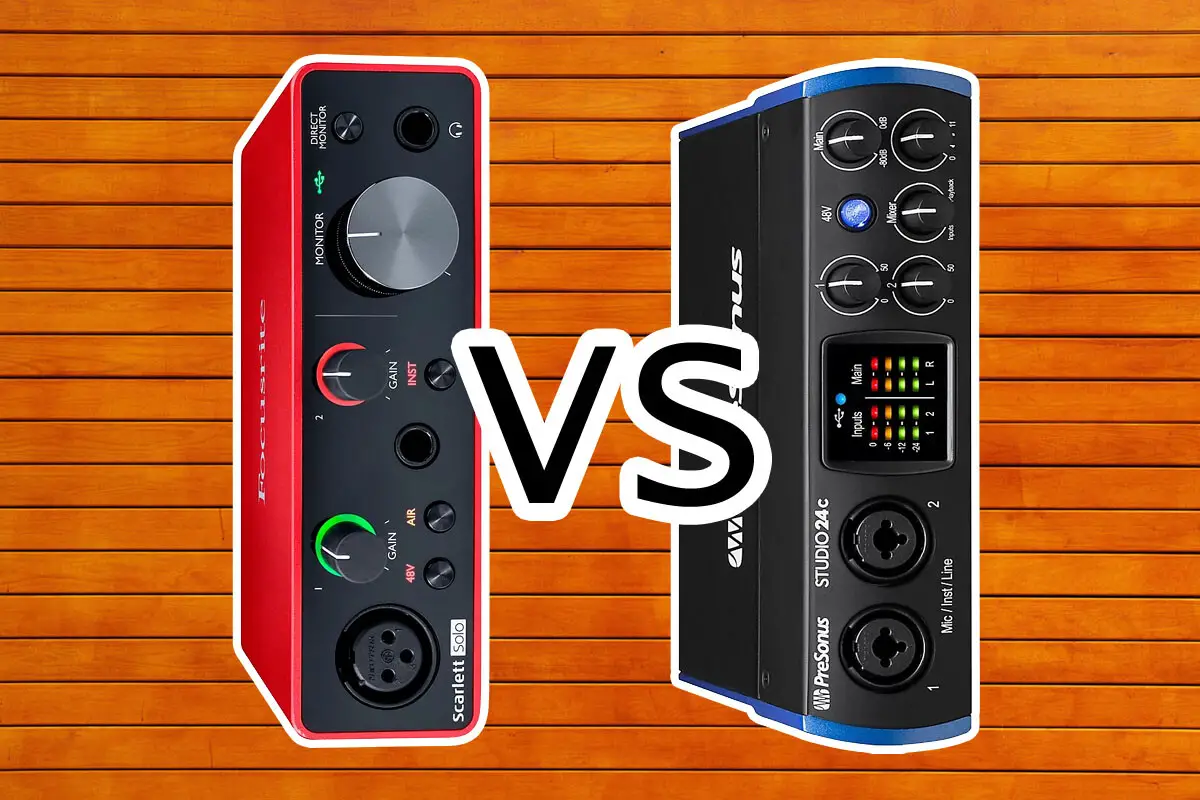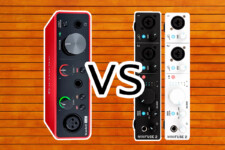Focusrite Scarlett Solo 3rd Gen vs PreSonus Studio 24c
If you are looking for a budget-friendly and easy-to-use audio interface for your home recording studio, you might have come across two popular options: the Focusrite Scarlett Solo 3rd Gen and the PreSonus Studio 24c.
Both of these devices are designed to provide high-quality sound and performance for singers, songwriters, podcasters, and other audio enthusiasts. But how do they compare and what are the main differences between them?

A Quick Look
- If you are looking for a simple and affordable interface that can add some warmth and brightness to your vocals and acoustic instruments, you might want to choose the Focusrite Scarlett Solo 3rd Gen. The Air mode can help you achieve a more airy and open sound that cuts through the mix better. The gain halo indicators can also help you set the optimal gain level for your recordings and avoid distortion or noise. The Focusrite Scarlett Solo 3rd Gen also comes with more plugins and a Splice Sounds subscription that can help you enhance your productions.
- If you are looking for a more versatile and flexible interface that can offer different headphone mixes and monitor levels, you might want to choose the PreSonus Studio 24c. The Cue Mix A/B function can help you create different monitor mixes for yourself and another performer, or for different recording scenarios. The multi-segment LED meters can also help you monitor the input and output levels of your recordings and avoid clipping or low volume. The PreSonus Studio 24c also comes with a full-featured DAW (Studio One Artist) and more plugins that can help you create professional-sounding tracks.

Focusrite Scarlett Solo 3rd Gen
- Mobile-ready, bus-powered, 2-in/2-out USB-C.
- Record at up to 24-bit/192kHz resolution.
- Two combo mic/line/instrument inputs with mic preamps.
- Two balanced 1/4″ TRS main outputs.
- Switchable Air mode that gives recordings a brighter and more open sound.
- Unique and intuitive halo level indicators that show you the input level and signal clipping at a glance.
- A direct monitor circuit that lets you monitor your input with low latency in one click.

PreSonus Studio 24c
- Mobile-ready, bus-powered, 2-in/2-out USB-C.
- Record at up to 24-bit/192kHz resolution.
- Two combo mic/line/instrument inputs with mic preamps.
- Two balanced 1/4″ TRS main outputs.
- A mix control knob that lets you blend analog inputs with playback from your computer for low-latency direct monitoring.
- Ladder-style LED level meters that are more detailed but less intuitive.
- MIDI In/Out ports that allow you to connect keyboards and other MIDI gear.
Common Features
Both the Focusrite Scarlett Solo 3rd Gen and the PreSonus Studio 24c share some common features that make them suitable for home recording. Here are some of them:
- Two inputs and two outputs: Both interfaces have one XLR mic input and one 1/4″ line/instrument input on the front panel, as well as two 1/4″ balanced line outputs on the back panel. This means you can record vocals and guitar or keyboard at the same time, or connect monitors or speakers to playback your recordings.
- 24-bit/192 kHz resolution: Both interfaces support high-resolution audio recording and playback, which means you can capture every detail of your sound source and enjoy clear and crisp sound quality.
- Phantom power: Both interfaces provide +48V phantom power to the mic input, which allows you to use condenser microphones that require external power. This is useful if you want to record vocals or acoustic instruments with a more detailed and accurate sound.
- Direct monitoring: Both interfaces have a direct monitoring feature that lets you hear your input signal without any latency or delay caused by your computer. This is helpful if you want to record with headphones and avoid hearing any echo or lag in your performance.
- MIDI I/O: Both interfaces have a MIDI input and output on the back panel, which allows you to connect MIDI keyboards, controllers, or other devices to your computer. This is useful if you want to use virtual instruments, trigger samples, or control parameters in your software.
- Bundled software: Both interfaces come with a variety of software that can help you start recording right away. See the end of this article for the full list, as it’s quite extensive.
Focusrite Scarlett Solo 3rd Gen Features
- Air mode: The Focusrite Scarlett Solo 3rd Gen has a feature called Air mode that can be activated by pressing a button on the front panel. This feature emulates the sound of the original Focusrite ISA preamp, which adds brightness and clarity to vocals and acoustic instruments. This can help you achieve a more airy and open sound that cuts through the mix better.
- Gain halo indicators: The Focusrite Scarlett Solo 3rd Gen has LED rings around the gain knobs that indicate the input level of your signal. The rings light up green when the signal is at a good level, red when the signal is clipping, and off when there is no signal. This can help you set the optimal gain level for your recordings and avoid distortion or noise.
PreSonus Studio 24c Features
- Cue Mix A/B: The PreSonus Studio 24c has a feature called Cue Mix A/B that can be activated by pressing a button on the front panel. This feature allows you to switch between two independent headphone mixes, which can be controlled by the software mixer in Studio One Artist. This can help you create different monitor mixes for yourself and another performer, or for different recording scenarios.
- Multi-segment LED meters: The PreSonus Studio 24c has four multi-segment LED meters on the front panel that indicate the input and output levels of your signal. The meters have eight segments each, with green, yellow, and red colors. This can help you monitor the input and output levels of your recordings and avoid clipping or low volume.
Price Comparison
The Focusrite Scarlett Solo 3rd Gen and the PreSonus Studio 24c are both affordable audio interfaces that offer great value for money. However, there is a slight difference in their price, depending on where you buy them from.
The Focusrite Scarlett Solo 3rd Gen costs around $130, while the PreSonus Studio 24c costs $150. This means that the Focusrite Scarlett Solo 3rd Gen is $20 cheaper than the PreSonus Studio 24c. However, this price difference may not be significant enough to influence your decision, as both interfaces offer similar features and performance.
Although The Focusrite Scarlett Solo 3rd Gen is slightly cheaper than the PreSonus Studio 24c, the latter comes with a more comprehensive DAW (Studio One Artist) and more plugins.
Sound Quality
The sound quality of an audio interface depends on several factors, such as the quality of the preamps, converters, drivers, and software. Both the Focusrite Scarlett Solo 3rd Gen and the PreSonus Studio 24c have high-quality components that ensure clear and transparent sound quality. However, there may be some subtle differences in their sound character and tone, depending on your personal preference and taste.
The Focusrite Scarlett Solo 3rd Gen has a slightly warmer and smoother sound that can add some color and richness to your recordings. The Air mode can also enhance the high frequencies and add some sparkle and presence to your vocals and acoustic instruments.
The PreSonus Studio 24c has a slightly cleaner and more neutral sound that can capture your sound source more accurately and faithfully. The Cue Mix A/B function can also help you create different headphone mixes that suit your recording situation.
Both interfaces have low noise and distortion levels, high dynamic range, and low latency performance. They also support high-resolution audio recording and playback up to 24-bit/192 kHz, which means you can capture every detail of your sound source and enjoy clear and crisp sound quality.
Compatibility
Both the Focusrite Scarlett Solo 3rd Gen and the PreSonus Studio 24c are compatible with Windows and Mac computers, as well as iOS devices (with an adapter).
They use USB 2.0 protocol to connect to your computer or device, which means they are plug-and-play and do not require any external power supply. They also come with drivers and software that can help you set up and configure your interface easily.
Both interfaces are also compatible with most popular DAWs (digital audio workstations), such as Ableton Live, Pro Tools, Logic Pro X, Cubase, FL Studio, Reaper, GarageBand, etc.
Focusrite Scarlett Solo 3rd Gen Pros
- Air mode adds brightness and clarity to vocals and acoustic instruments.
- Gain halo indicators help set optimal gain level.
- Cheaper than PreSonus Studio 24c.
- Comes with more plugins and Splice Sounds subscription
Focusrite Scarlett Solo 3rd Gen Cons
- Only one mic preamp and one line/instrument input.
- No pad or high-pass filter on the inputs.
- Comes with a lite version of Ableton Live
PreSonus Studio 24c Pros
- Cue Mix A/B allows switching between two headphone mixes.
- Multi-segment LED meters help monitor input and output levels.
- Comes with a full-featured DAW (Studio One Artist) and more plugins.
PreSonus Studio 24c Cons
- More expensive than Focusrite Scarlett Solo 3rd Gen.
- No Air mode or similar feature to enhance the sound.
- Comes with a lite version of Ableton Live.
Focusrite Scarlett Solo 3rd Gen vs PreSonus Studio 24c: The Final Verdict
The Focusrite Scarlett Solo 3rd Gen and the PreSonus Studio 24c are both great audio interfaces that can meet your home recording needs. They have similar features and performance, but also some distinctive features that make them unique and different from each other. Ultimately, the choice between them depends on your personal preference, budget, and recording situation.
If you want a simple and affordable interface that can add some warmth and brightness to your vocals and acoustic instruments, go for the Focusrite Scarlett Solo 3rd Gen. If you want a more versatile and flexible interface that can offer different headphone mixes and monitor levels, go for the PreSonus Studio 24c.
Either way, you won’t regret choosing either of these interfaces, as they are both reliable, easy-to-use, and high-quality devices that can help you record amazing sound at home.
Focusrite Scarlett Solo 3rd Gen: Bundled Software
- Ableton Live Lite (a lite version of a popular DAW).
- Pro Tools First Focusrite Creative Pack (a lite version of another popular DAW with some plugins).
- Three months of Splice Sounds subscription (a platform that offers royalty-free samples, loops, and presets).
- Focusrite Red Plug-in Suite (a collection of EQ and compressor plugins).
- Softube Time and Tone Bundle (a collection of reverb, delay, distortion, and modulation plugins).
- XLN Audio Addictive Keys (a virtual piano plugin).
- Focusrite Plug-in Collective (a program that offers free plugins every few months).
PreSonus Studio 24c: Bundled Software
- Studio One Artist (a full-featured DAW).
- Studio Magic Plug-in Suite (a collection of plugins from various brands).
- Ableton Live Lite (a lite version of a popular DAW).
- Brainworx bx_rockrack V3 Player (a guitar amp simulator plugin).
- SPL Attacker Plus (a transient shaper plugin).
- Lexicon MPX-i Reverb (a reverb plugin).
- Klanghelm SDRR2tube (a tube saturation plugin).
- Output Movement (a rhythm processor plugin).
- Native Instruments Replika (a delay plugin).
- Cherry Audio Voltage Nucleus (a modular synth plugin).
- UJAM Virtual Drummer 2 PHAT (a virtual drummer plugin).
- KV331 Audio Synthmaster Player (a synth plugin).
- Mäag Audio EQ2 (an equalizer plugin).




